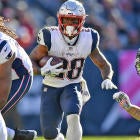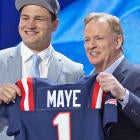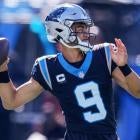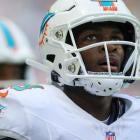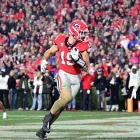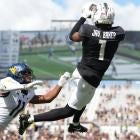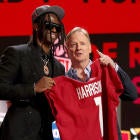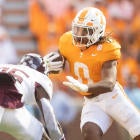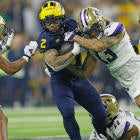Welcome to our 2019 Player Profiles series. We are going through the top 100 in the consensus PPR rankings of Heath Cummings, Jamey Eisenberg and Dave Richard to give you the case for and the case against drafting each player. By the time you're done, you'll know everything you need to know for drafting in 2019.
Some talented wide receivers and running backs plus plus a prime potential top-tier tight end fit among 50-41:
50. Tarik Cohen, RB, CHI
The Case For: Cohen took his game to a new level in 2018, increasing his catch rate, yards per carry and yards per reception. He even got into the end zone on a more regular basis. Then the Bears jettisoned Jordan Howard to Philadelphia. This looks a lot like they settled on Cohen as the more productive back and want to see him on the field more often. A feature role isn't likely, but he was the No. 11 back in 2018 with just 170 touches. Any type of increase could vault him into the top-10. Cohen also gets a boost in leagues that count return yards and return touchdowns. He led the NFL in punt return yardage in 2018.
The Case Against: He's 5-foot-6 and weighs 180 pounds. That doesn't stop him from dominating in his scatback role, but it probably does prevent him from seeing 250 touches. If it doesn't then Mike Davis and David Montgomery will. Both backs are well-suited for an early-down role and there's already been speculation in Chicago that Cohen could actually see fewer carries, but more targets, in 2019. That should make you leery of Cohen in non-PPR.
49. Phillip Lindsay, RB, DEN
The Case For: Lindsay was phenomenal as a rookie, averaging 5.4 yards per carry, catching 75 percent of his targets and scoring 10 touchdowns. He showed big-play ability with three carries that went for more than 40 yards and had success inside the red zone as well with five touchdowns on six carries inside the 5. The Broncos were very successful running the football in 2018 and Lindsay was a big reason why.
The Case Against: He still hasn't fully recovered from his wrist injury suffered at the end of the season, which only highlights the injury concern for a smaller back like Lindsay. It also seems very likely he'll remain in a committee; he only had three games last season with more than 15 carries. A non-workhorse on what looks like a below-average offense has to be remarkably efficient to be a top-15 running back. Lindsay was that in 2018, but it's a little scary counting on that again this year.
48. James White, RB, NE
The Case For: Rob Gronkowski is gone, which opens up the possibility White could be the team's de facto No. 2 receiver. He actually led the team in targets and receptions last season, and he should be second in 2019. In PPR leagues, White is a solid No. 2 running back with No. 1 upside.
The Case Against: The target picture got much murkier when the team spent a first-round pick on N'Keal Harry. And the running back room got more crowded when they drafted Damien Harris. At the very least, the case is easy to make if you play in a non-PPR league. Yes, White was good in that format last year, but that's mostly because he scored 12 touchdowns. His career high before last year was six scores.
47. Kenny Golladay, WR, DET
The Case For: Draft Golladay because you're looking for a future star. Because of his size, his speed and the fact that defenses simply cannot cover him with one defender. He's a hulk of a man who makes highlight-reel plays and is entering his famed third year, the year we've come to look for breakouts for receivers. Golden Tate is gone and Golladay had some monstrous games after he was traded in 2018.
The Case Against: While Golladay did take off after the Tate trade, he also broke out after the team lost Marvin Jones for the season and Jones will be back in 2019. Golladay had some real duds down the stretch even when he was "the man." That may have not been on him because the offensive coaching on this team was not great and Matthew Stafford wasn't either. But do you really feel better with Darrell Bevell in charge? If Matt Patricia has his way, this will be a defense-first team that excels in the running game. It's almost like they're trying to make it harder for Golladay to break out. Also, the fact that the team spent a first-round pick on T.J. Hockenson suggests they may want to get the tight ends more involved in the passing game.
46. David Montgomery, RB, CHI
The Case For: Jordan Howard had 250 carries in 2018 and Montgomery should slide right into that role. What he has on Howard is a more complete game, with good chops in the receiving game. This will allow the Bears to be less predictable on offense and should help keep Montgomery on the field..
The Case Against: Montgomery's ability in the passing game may not matter since he's sharing a backfield with Cohen. Also, Cohen isn't the only back he's sharing with. The Bears signed Mike Davis in the offseason and Davis has a lot of the same positive qualities as Montgomery. There's no guarantee Montgomery is dominating early-down touches to start the season.
45. Derrick Henry, RB, TEN
The Case For: Do you remember what Derrick Henry did in the last four games of the season? He ran for 585 yards and seven touchdowns. In four games. The Titans messed around with a committee approach for far too long last year, but they found what worked late in the season, and I expect them to pound the rock in 2019. Henry should be a workhorse back in an offense built to run. He won't match the pace he had at the end of 2018, but he will have the best year of his career.
The Case Against: How much should four games matter in the context of a full season? Because it wasn't just that Henry didn't get the ball enough early in the year. He was also pretty bad. That's not to say he is bad, he's a talented back. But placing too much weight on those last four games could cause you to take Henry way too early. This is especially true considering the unknowns surrounding the Titans offense, including offensive coordinator Arthur Smith. One other knock against Henry is his PPR value. He didn't catch more the two passes in any game last year and has never caught more than 15 passes in a full season.
44. Chris Godwin, WR, TB
The Case For: By the time we get to August, Godwin may be everyone's favorite third-year breakout pick at receiver, and it's easy to see why. DeSean Jackson and Adam Humphries are both out. Offensive guru Bruce Arians is in. Godwin has caught 62 percent of his targets for his career and averaged 14.7 yards per reception. If he sees an upgrade to 120 targets (that seems low), we're looking at close to 1,100 yards with that efficiency. He had 95 targets last year, but 179 went to Jackson and Humphries. The sky is the limit for Godwin in his third year.
The Case Against: The verdict is still out on just how good Jameis Winston is, and we don't exactly how he'll react to the coaching and philosophy change. Arians is a brilliant mind, but it's still a bit of a question mark how they'll mesh, and there's no Fitzmagic to save the day if Winston falters. It's also dangerous to project the same efficiency for Godwin when he'll see more defensive attention now that he's the clear No. 2. Besides, we know how much Winston loves throwing to his tight ends, and he still has O.J. Howard and Cameron Brate.
43. Cooper Kupp, WR, LAR
The Case For: Kupp has phenomenal rapport with Jared Goff. After a surprisingly productive rookie year, he was on his way to a breakout season in 2018 before injuries derailed him. When he's healthy, he's Goff's favorite target in the red zone and benefits greatly from the attention paid to Robert Woods and Brandin Cooks. If he plays a full season in 2019, he'll be a threat to top 1,000 yards and score double-digit touchdowns.
The Case Against: He's still rehabbing from his ACL injury, and the plan calls for him to be eased into training camp. While there's hope he'll be 100% for the start of the season, it's still a bit of an unknown. With Cooks, Woods and Todd Gurley on the roster, there's already a target squeeze, so it wouldn't be surprising to see him get off to a slow start.
42. Evan Engram, TE, NYG
The Case For: With Odell Beckham out of the picture, Engram figures to see a boost in targets. He's averaged almost nine targets per game in games with Beckham the past year, which is elite usage for a tight end. While Engram's counting numbers went down last season, he was actually far more efficient. He caught 70 percent of his targets and averaged 12.8 yards per reception. If he can maintain that efficiency with increased usage, Engram could join the big three tight ends as another elite option.
The Case Against: The problem with using Engram's numbers without Beckham is that you're not accounting for the impact of Golden Tate. Tate won't command the same target share Beckham did, but the combination of Tate and Sterling Shepard may tamp down Engram's upside a little bit, especially with Saquon Barkley taking 20 percent of the team's targets.
41. Robert Woods, WR, LAR
The Case For: After four years spent wandering in Buffalo, Robert Woods is turning into a star. He had a very good 2017 hampered only by an injury that cost him four games and then stayed healthy last year and finished as a top-10 wide receiver in PPR. Woods has just about everything you want in a No. 2 receiver. The talent is unquestioned, he has a good young quarterback he's already familiar with, and the system is nearly unstoppable. He's led the team in targets per game each of the past two years and is the No. 1 receiver, as much as the team has one.
The Case Against: The problem of course, is the Rams don't really have a No. 1 receiver. In 2017 no one on this team reached 100 targets, and Woods himself was only on pace for 113. That number went up last year, but that had at least a little to do with Cooper Kupp's injuries. Woods has also never topped six touchdowns in a season, and Sammy Watkins is the only receiver to top that number in Los Angeles the past two seasons. Spreading the ball around works really well for the Rams, but it's not great for their Fantasy upside.




















